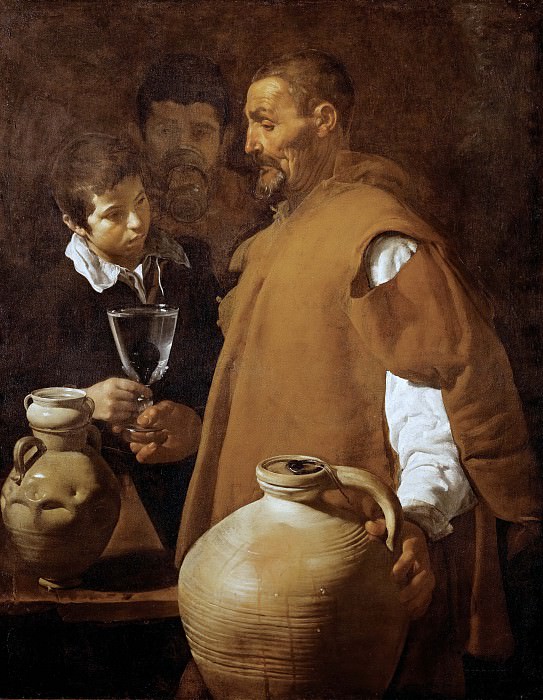Waterseller of Seville Diego Rodriguez De Silva y Velazquez (1599-1660)
Diego Rodriguez De Silva y Velazquez – Waterseller of Seville
Edit attribution
Download full size: 2944×3800 px (2,2 Mb)
Painter: Diego Rodriguez De Silva y Velazquez
Location: Private Collection
The painting "Water Carrier" was painted in 1622 by the extraordinarily gifted and educated Spanish painter Velázquez. It also has another title, The Seller of Water of Seville. With this painting the artist completed his cycle of works bodegones (translated from Spanish - tavern). This cycle includes a number of paintings, but the "Water-carrier" became the brightest pearl of the gallery. Contemplating this canvas, we seem to see moments from the life of a simple man of the time, so brightly and realistically conveyed every stroke of faces, clothing and objects. In "The Water Seller of Seville" Velázquez appears before us not only as a venerable creator of his paintings, but also as a careful observer, as a man who is well versed in the feelings of people, in emotions, knows their history and traditions. The painting depicts an elderly man who is a communicant of water, the ironic name given to heretics, sectarians who did not consume meat or wine, and who put ordinary pure water at the center of everything. One can see the sense of importance with which the water bearer hands the transparent glass to the young teenager and the reverence with which the boy accepts the glass. Some kind of enchanting mystery wafts from this picture. The strange water carrier, engrossed in his own thoughts, the boy’s face reflecting his thoughts, the strange, dark figure of the large man in the background. The hands on the stem of the glass, as if to symbolize the meeting of the two times - the old hand passes water to youth.
Description of Diego Velázquez’s painting "Water-carrier"
The painting "Water Carrier" was painted in 1622 by the extraordinarily gifted and educated Spanish painter Velázquez. It also has another title, The Seller of Water of Seville.
With this painting the artist completed his cycle of works bodegones (translated from Spanish - tavern). This cycle includes a number of paintings, but the "Water-carrier" became the brightest pearl of the gallery.
Contemplating this canvas, we seem to see moments from the life of a simple man of the time, so brightly and realistically conveyed every stroke of faces, clothing and objects.
In "The Water Seller of Seville" Velázquez appears before us not only as a venerable creator of his paintings, but also as a careful observer, as a man who is well versed in the feelings of people, in emotions, knows their history and traditions.
The painting depicts an elderly man who is a communicant of water, the ironic name given to heretics, sectarians who did not consume meat or wine, and who put ordinary pure water at the center of everything.
One can see the sense of importance with which the water bearer hands the transparent glass to the young teenager and the reverence with which the boy accepts the glass.
Some kind of enchanting mystery wafts from this picture.
The strange water carrier, engrossed in his own thoughts, the boy’s face reflecting his thoughts, the strange, dark figure of the large man in the background.
The hands on the stem of the glass, as if to symbolize the meeting of the two times - the old hand passes water to youth. Water has always been a symbol of life, so what is the elder handing over to the youth?
Some art critics argue that the painting is not so much an overt meaning as an allegory. In the center of the picture a bright spot stands out a glass of water. A fig tree can be seen at the bottom of the glass.
Perhaps figs are used to give the water a special flavor, or maybe the artist painted this detail in connection with the fact that figs are a symbol of eroticism. Then the boy’s seriousness and the water-carrier’s detachment are understandable. The water-carrier only offers the young man the forbidden fruit, and it is the boy’s choice to accept or refuse such a symbol. The young man, on the other hand, accepts the glass.
Кому понравилось
Пожалуйста, подождите
На эту операцию может потребоваться несколько секунд.
Информация появится в новом окне,
если открытие новых окон не запрещено в настройках вашего браузера.
You need to login
Для работы с коллекциями – пожалуйста, войдите в аккаунт (open in new window).




















You cannot comment Why?